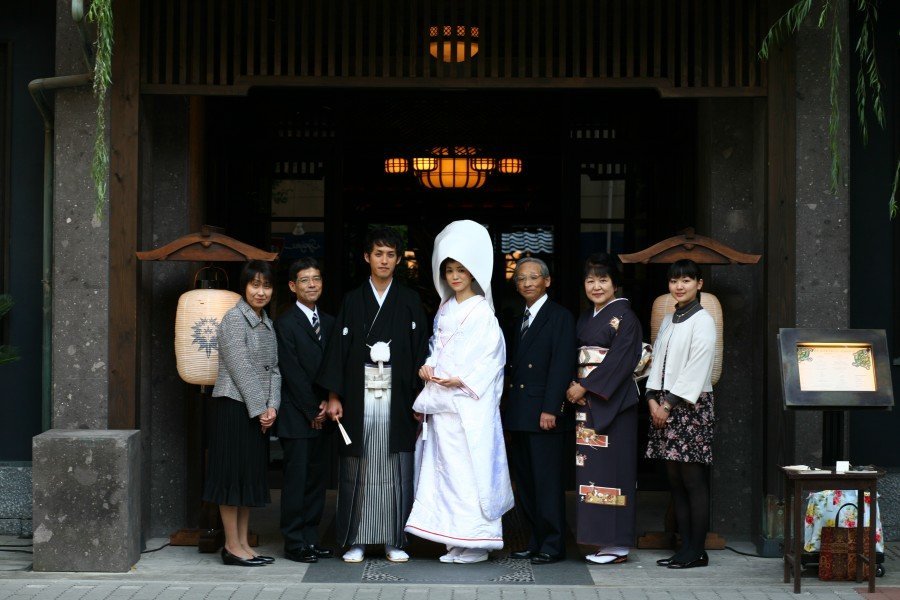Like this post? Help us by sharing it!
With wedding fever well and truly upon us last week, here in the UK office we started wondering about how Japanese weddings work. Maddy interviewed Tomoko from our Japan office, who got married in November 2009. She kindly provided us with the following fascinating information, and let us show you a Japanese wedding with her beautiful photos. Arigatou Tomoko!
[slideshow size=”half-width”]
Maddy: When did you get married?
Tomoko: On Sunday 8th November 2009
What did you and your husband wear?
I wore a traditional Japanese white kimono wedding dress called a shiromuku for the ceremony, and my husband wore a traditional Japanese haori hakam (a coat worn over a divided skirt). At the party I wore a white dress similar to a Western wedding dress, and my husband wore a tuxedo.
What did you do on your wedding day?
In the morning, my husband and I got dressed at the restaurant where we were going to have our reception. This restaurant specialises in weddings, and we organised the outfits, flowers, food and gifts through them. Then we went to the shine, where the guests were already. The shrine is called Aichi-ken Gokoku Jinji, and is not far from IJT’s office in Nagoya.
Before the ceremony, our families met in a room and we introduced everyone. Then we went outside, washed our hands to purify ourselves and we walked quietly side by side from the torii gate to the main hall of the shrine.
The ceremony lasted about an hour. The shinto priest prayed and my husband and I made wedding vows, exchanged rings and did san san kudo and we had a dance performance by shinto maiden .
Can you explain san san kudo and shinto maiden please?
They are Japanese wedding customs. In san san kudo, the bride and groom take turns to sip from the same sake cup. We use three cups and sip three times from each sake cup, which makes 9 sips in total. That is why we call it san san kudo, which means ‘three three nine times’. Through this the bride and gloom promise that they will live together for life and go through any difficulties together.
Shinto maiden are girls who assist with shrine functions and perform ceremonial dances. They wear red hakama (long pleated red trousers) and a white haori (jacket), with red and white ribbons in their hair.
What happened after the ceremony?
After the ceremony we took a family photo at the shrine. Then we moved to a nearby restaurant for the party.
My husband made a welcome speech and we cut the wedding cake. Our cake was decorated with fresh cream and fruit. The cutting of the cake is said to symbolise the first thing that the bride and groom do together. My husband’s friend made a short speech and everyone raised their glasses in a toast to us. Then we sat down for a meal, which was a kind of Japanese and French fusion cuisine.
When we finished the meal we gave a thank you letter and presents to our parents. We gave them digital photo frames with photos of our childhood. My husband made a speech to thank them, and his father also gave a speech.
How many people came to the ceremony and party?
About 30 people came to both; just very close relatives and friends.
What presents did you receive?
We don’t usually receive presents from our guests, instead we receive money. Guests are expected to give crisp, new notes in a sort of envelope decorated with mizuhiki, which is a cord made from rice paper. You put your name on the envelope and some people also put a message card inside. The guests don’t give the envelope directly to the couple; instead they give it to the reception desk before the party.
Usually close friends work as receptionists (but we asked our younger sister and brother to do it as we did not invite many friends). The bride and groom receive the money after the party. Often friends and relatives who are not invited to the party also choose to give money.
Did you give any presents to your guests?
Yes, we used a mail order gift system. We chose a catalogue that contains a variety of gifts and the guests could each choose one gift. It’s also common to give guests something sweet, and we gave our guests some flavoured Danish bread. It is also traditional to give guests something lucky, so we gave a kind of seaweed called konbu, which sounds similar to yorokobu, which means delighted or pleased and is considered to bring luck! The guests received 5 kinds of konbu wrapped in a Japanese cloth. These were the three main presents we gave the guests, but in addition we also gave a little message card, a handmade corsage and a small chocolate.
And finally, we must ask: did you go on honeymoon?
Yes, we went to Yokohama to eat Chinese food in China town, Tokyo DisneyLand and DisneySea to have fun, and Hakone to relax and enjoy the onsen (hot spring baths)!
Thanks again Tomoko for sharing your memories of your wedding day. I’m sure everyone will agree that you looked beautiful!


